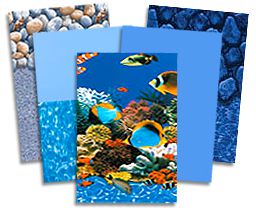FREE Standard Shipping On All Orders $100 or More!*
Selecting a New Inground Pool Liner - Vinyl Thickness
Now that you have taken measurements for an inground pool liner or hired a professional to measure the pool for you - it is time to choose a replacement pool liner. That is one advantage of having a vinyl liner pool - is that when you need to replace it you can purchase a totally different color and design than what you had before. This will give your pool a totally different look than what you had in the past. For instructions on measuring an inground pool liner, see our previous blog post on the topic.
Folks tend to choose specific inground liner patterns for different reasons. They may choose a style to match their home, the decor of their backyard or sometimes the kids pick the liner pattern. With nearly 60 different liner patterns to choose from, it can be a difficult choice!
In addition to pattern or style, we sell 3 different thicknesses of inground pool liners: 20 mil, 28 mil wall and 20 mil floor, and an all-over 27 mil thick liner. This is what I want to talk about today, and discuss the benefits of each thickness, to help you make your decision on the best liner to install in your own inground pool.
The most common thickness of inground pool liners would be our 20 mil material, which some companies call 25 gauge. When shopping for a new inground vinyl liner you may see both terms used to describe a liner's thickness. Before you purchase your replacement pool liner, make sure you are comparing apples to apples. At SPP, we always use the industry standard "mil" thickness (not "gauge"). When it comes to choosing a liner, the 20 mil thickness is typically the least expensive and on average normally lasts about 10- 12 years.

An upgrade to the standard 20 mil liner would be the 28/20 mil liner and the advantage of this style liner would be you have the extra thickness 28 mil on the wall and 20 mil on the floor. The extra thickness on the wall allows for more stretching of the liner, more puncture resistance on the wall, and increased protection from ultra violet rays.
Thicker pool liners are more puncture resistant, true - but they also contain more resins and plasticizers, so... a thicker liner should withstand harsh water conditions and UV exposure better than thinner. Typically the 28/20 liners are a little more expensive than a straight 20 mil liner, but it's worth the extra cost because of the increased lifespan, over the 20 mil material.
Finally, our last option which would be the best option - a full 27 or 28 mil (depending on which manufacturer you choose). This is our thickest inground pool liner, and we do have some of these liners on our closeout page where you can get a 27/28 mil liner at the 20 mil price. See website for liner patterns that are available. If you are interested in a thicker, more durable liner, the 27 mil "all-over" is the thickest available.
Some of our competitors call the 27 mil liner a 34 gauge - we use the industry standard term "mil" so as not to confuse our customers. This liner will have the extra thickness on the wall and on the floor. Whether you live in a warm climate like Nevada or a cold climate like Connecticut, this liner would be your best option. You have fewer worries about the ultra violet rays weakening and fading your pool liner. For pools in the snowbelt - even with severe winter ice and snow, there is less chance of ice damage to a thicker liner.

With a thicker pool liner, if something sharp was to come into contact with your liner (animals claws or sharp edged cleaning tools), there is less chance of any damage and having to replace or repair your liner. Also, thicker liners help prevent anything from coming up (from beneath the liner) and punching through the liner. 27 mil liners will typically last longer than thinner liners, with a normal life expectancy of approximately 16 years.
We do have some closeout liner patterns available where you can get a 28/20 mil liner at the same 20 mil price see our website to view different liner options. Pool liner manufacturers change liner patterns regularly, to keep up with changing tastes and sales patterns. Closeout liners carry a full warranty, and will last just as long as a new pattern. You can save up to 25%, when you help us clear out this inventory!
Hopefully, reading about the 3 different thickness options we have for inground liners has helped you decide what is best for your backyard swimming pool. If you still are not sure what is best give us a call and we can assist you in choosing the correct liner.